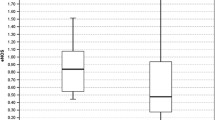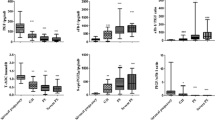Abstract
Preeclampsia or pregnancy-induced hypertension is a major cause of both maternal and fetal-neonatal morbidity and mortality. The deficiency of vitamin E can cause accumulation of lipid peroxidation products, which, in turn, can induce vasoconstriction. This study has examined any evidence of increased cellular lipid peroxidation and accumulation of malonydialdehyde (MDA, an end product of lipid peroxidation) in pregnancy-induced hypertension and any relationship between the elevated MDA and lower vitamin E levels with hypertension in pregnant women. EDTA-Blood was collected from pregnant women at the time of delivery. Plasma vitamin E was determined by HPLC; MDA by the thiobarbituric acid-reactivity. Subjects with diastolic blood pressure(DBP) ≥90 mm Hg were considered hypertensive (HT) and with <90 mm Hg normotensive (NT). Data (Mean±SE) from 49 NT and 11 HT women show that HT has significantly lower vitamin E (22±1 vs 27±1 nmole/ml, p<0.03) and elevated MDA levels (0.56±0.06 vs 0.43±0.02 nmole/ml, p<0.03) compared to NT; the ages and gestational ages of women were similar. Among all women, there was a significant positive relationship between DBP and MDA levels (r=0.27, p<0.05), and a significant negative relationship between vitamin E levels and DBP (−0.36, p<0.005), and a significant negative relationship between MDA and vitamin E levels (r=−0.27, p<0.05). Thus, HT women's plasma has significantly lower E and higher MDA levels, and DBP significantly correlates with the extent of vitamin E deficiency and increased MDA levels. This study suggests a relationship between elevated lipid peroxidation and lower vitamin E levels and hypertension in pregnancy (preeclampsia).
Similar content being viewed by others
References
Zemel MB, Zemel PC, Berry S et al.: Altered platelet calcium metabolism as an early predictor of increased peripheral vascular resistance and preeclampsia in urban black women. New Engl J Med 323: 434–438, 1990
Wang Y, Walsh SW, Guo J, Zhang J: The imbalance between thromboxane and prostacyclin in preeclampsia is associated with an imbalance between lipid peroxides and vitamin E in maternal blood. Amer J Obstet Gynecol 165: 1695–1700, 1991
Tsukatani E: Etiology of EPH-gestosis from the viewpoint of dynamics of vasoactive prostanoid, lipid peroxides and vitamin E. Acta Obst Gynaec Jpn 35: 713–720, 1983
Hubel CA, Roberts JM, Taylor RN et al.: Lipid peroxidation in pregnancy: New Perspectives on preeclampsia. Amer J Obstetr and Gynecol 161: 1025–1034, 1989
Strauss MB: Observations on the etiology of the toxemias of pregnancy. The relationship of nutritional deficiency, hypoproteinemia, and elevated venous pressure to water retention in pregnancy. Amer J Med Sci 190: 811–824, 1935
Williams PF: The relation of vitamin B1 to the reproductive cycle. Amer J Obstetr and Gynecol 40: 181–193, 1940
Chaudhuri SK: Correlation of toxemia with anemia of pregnancy. Amer J Obstetr and Gynecol 106: 255–259, 1970
Chaudhuri SK: Role of nutrition in the etiology of toxemia of pregnancy. Amer J Obstet and Gynecol 110: 46–48, 1971
Brophy MH, Siiteri PK: Pyridoxal phosphate and hypertensive discorders of pregnancy. Amer J Obstetr and Gynecol 121: 1075–1079, 1975
Paulose CS, Dakshinamurthi K, Packer S, Stephens NL: Sympathetic stimulation and hypertensive in the pyridoxine-deficient adult rat. Hypertension 11: 387–391, 1988.
Belzian JM, Villar J, Repke J: The relationship between calcium intake and pregnancyinduced hypertension: Up-to-date evidence. Amer J Obstet Gynecol 158: 898–902, 1988
Cherry FF, Bennett EA, Bazzano GS, Johnson LK, Fosmire GJ Batson HK: Plasma zinc in hypertension/toxemia and other reproductive variables in adolescent pregnancy. Amer J Clin Nutr 34: 2367–2375, 1981
Weiss ST, Turk J, Needleman P: A mechanism for the hydroperoxidemediated inactivation of prostacyclin synthetase. Blood 53: 1191–1196, 1979
Sanderud J, Norstein J, Saugstad OD: Reactive oxygen metabolites produce pulmonary vasoconstriction in young pigs. Pediatr Res 29: 543–547, 1991
Rhoades RA, Packer CS, Roepke DA, Jin N, Meiss RA: Reactive oxygen species alter contractile properties of pulmonary arterial smooth muscle. Can J Physiol Pharmacol 68: 1581–1589, 1990
Iwama Y, Muramatsu M, Toki Y, Miyazaki Y: The mechanism of vasoconstriction induced by oxygen-derived free radicals in rat aorta. Japs J Pharmacol 58 (Suppl 2):309, 1992
Gurtner GH, Knoblauch A, Smith PL, Sies H, Adkinson NF: Oxidant and lipid-induced pulmonary vasoconstriction mediated by arachidonic acid metabolites. J Appl Physiol 55: 949–954, 1983
Asano M, Hidaka H: Contractile response of isolated rabbit aortic strips to unsaturated fatty acid peroxides. J Pharm Exp Ther 208: 347–353, 1979
Hubel CA, Davidge ST, McLaughlin MK: Lipid hydroperoxides potentiate mesenteric artery vasoconstrictor responses. Free Radical Biol Med 14: 397–407, 1993
Liao DF, Chen X: Prostacyclin-mediated protection by angiotensinconverting enzyme inhibitors against injury of aortic endothelium by free radicals. Cardioscience 3: 79–84, 1992
Jain SK: Hyperglycemia can cause membrane lipid peroxidation and osmotic fragility in human red blood cells. J Biol Chem 264: 21340–21345, 1989
Hatam LJ, Kayden HJ: A high performamce liquid chromatographic method for the determination of tocopherol in plasma and cellular elements of the blood. J Lipid Res 20: 639–645, 1979
Ishihara M: Studies on lipoperoxide of normal pregnant women and of patients with toxemia of pregnancy. Clinica Chimica Acta 84: 1–9, 1978
Maseki M, Nishigaki I, Hagihara M, Tomoda Y, Yagi K: Lipid peroxide levels and lipid content of serum lipoprotein fractions of pregnant subjects with or without pre-eclampsia. Clinica Chimica Acta 115: 155–61, 1981
Wickens D, Wilkins MH, Lunec J, Ball G, Dormandy TL: Free-radical oxidation (peroxidation) products in plasma in normal and abnormal pregnancy. Ann Clin Biochem 18: 158–62, 1981
Garzetti GG, Tranquilli AL, Cugini AM, Mazzanti L, Cester N, Romanini C: Altered lipid composition, increased lipid peroxidation, and altered fluidity of the membrane as evidence of platelet damage in preeclampsia. Obstetrics Gynecology 81: 337–40, 1993
Author information
Authors and Affiliations
Rights and permissions
About this article
Cite this article
Jain, S.K., Wise, R. Relationship between elevated lipid peroxides, vitamin E deficiency and hypertension in preeclampsia. Mol Cell Biochem 151, 33–38 (1995). https://doi.org/10.1007/BF01076893
Received:
Accepted:
Issue Date:
DOI: https://doi.org/10.1007/BF01076893




